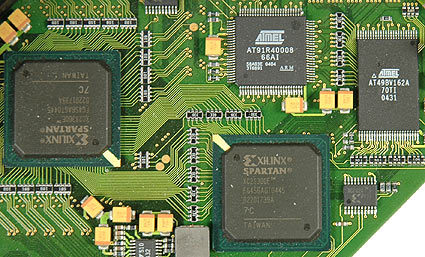A New RAM Hard Drive from HyperOs
HyperDrive III Details
We received a HyperDrive III version that has been discontinued pending enhancements to its successor. However, the performance characteristics will remain at least equal, according to Gordon Ritchie, CEO of HyperOs Systems Limited. Our HyperDrive III came without the 5.25" housing that is required to install it in a computer case (see intro image of this article). However, this omission was unimportant for our performance tests.
Memory actually is the most interesting difference between Gigabyte's i-RAM and the HyperDrive III. While i-RAM uses conventional unbuffered memory, the HyperDrive III needs to be equipped with registered ECC DDR RAMs. Obviously, these get more expensive as capacity requirements increase.
While the Gigabyte i-RAM will host up to four DDR DIMMs, the HyperDrive III test sample is able to accommodate as many as six modules. However, the version that HyperOs Systems is about to ship will offer a total of eight DIMM sockets, allowing for a maximum storage capacity of 16 GB when equipped with 2 GB DDR DIMMs, eclipsing the i-RAM with its 4 GB maximum capacity. Technically, it would be able to sustain as much as 8 GB of capacity, but there are no 2 GB unbuffered DIMMs available.
We don't recommend going to a retail shop to purchase memory prior to checking the HyperDrive II's requirements. All modules need to be similar in terms of capacity and chip geometry. Also, HyperOs Systems defines 18 chips per module as the maximum. In exchange, you are free to choose manufacturer and DDR memory speeds. The device won't operate the DDR DIMMs at their rated clock speed anyway, since the RAM devices will outperform the storage interface, even with low clock speeds.
Compared to the i-RAM, HyperOs Systems picked the inferior UltraATA/100 interface, which would represent a bottleneck even for PC66 SDRAM memory. Again we want to refer to the current HyperDrive III version: Not only will it support more DIMM sockets, but it will also offer both UltraATA/100 and Serial ATA 150 interfaces and a jumper for both options. Yet we can't comment on performance as we did not receive the latest version for testing.
Indeed, the interface proves to be a disadvantage since the HyperDrive III cannot deliver the bandwidth that would result from two Ultra320 SCSI hard drives in a RAID 0 setup. Still the subjective performance of the HyperDrive III is noticeable and considerably better since the memory access is quicker compared to the mechanical operation of a hard drive.
The circuit board of the HyperDrive III is made in Germany by a company called DCE.
Get Tom's Hardware's best news and in-depth reviews, straight to your inbox.
Current page: HyperDrive III Details
Prev Page A DRAM Hard Drive For Professional Apps? Next Page Buffer Battery
Patrick Schmid was the editor-in-chief for Tom's Hardware from 2005 to 2006. He wrote numerous articles on a wide range of hardware topics, including storage, CPUs, and system builds.


